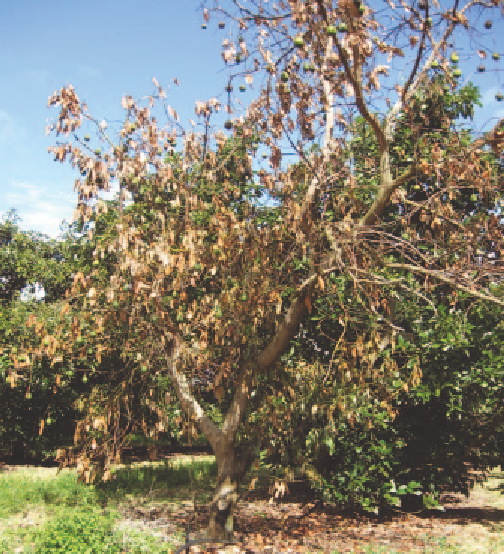Agriculture Reference
In-Depth Information
A thin, white layer of mycelium can be found between the
bark and the wood.
trees. This will prevent the pathogen spreading to
healthy trees.
Fruiting bodies may be present in wet weather. They are
black, leathery to woody, and hard.
Protect pruning wounds with fungicides followed
by painting to prevent infection.
•
Source of infection and spread
Phellinus noxius
is a saprophyte that colonises cut stems or
dead wood. Air-borne spores infect pruning wounds and
the disease spreads through root-to-root contact, killing
successive trees.
CERCOSPORA SPOT
■
Cause
The fungus
Pseudocercospora purpurea
.
Symptoms
Small (1-5 mm), angular, purple to brown leaf spots are
produced; these develop chlorotic haloes with age. Under
high humidity, sporulation of the causal fungus may be
seen in lesion centres as grey felty growths. Lesions may
coalesce to form large dead areas on the leaf. Defoliation
may occur.
Importance
Phellinus noxius
is severe where it occurs. The fungus has
a wide host range and is prevalent in soils that previously
supported rainforest.
Management
•
The disease is diffi cult to manage.
Dark brown to black, 2-10 mm lesions can develop on small
stems and fruit pedicels. Fruit lesions first appear as small
dark flecks that, in time, coalesce into circular brown to
black spots. These spots become cracked or fissured, which
may allow other pathogens to enter. The disease is usually
superficial but the pathogen may invade the flesh during
advanced stages.
When establishing a new orchard, remove all
stumps, roots and dead wood and leave fallow for
6 to 12 months.
•
Uproot stumps when thinning orchards.
•
If tree-to-tree spread is occurring along rows, dig
isolation trenches or install root barriers around infected
•
Source of infection and spread
Initial inoculum comes from infected leaves. Conidia are
produced in abundance during warm, rainy weather. They
are carried by wind, rain, irrigation water or insects to
infection courts. After penetration, the pathogen remains
latent for approximately three months. Fruit from
one-quarter to three-quarter size are susceptible, and very
young fruit and fruit near maturity are resistant. Severe
disease can develop if warm, rainy weather occurs when
fruit are about a quarter size.
Importance
Currently, the pathogen is confined to the Atherton
Tableland where it was detected in 1992. In warm, humid
and rainy climates, losses can be high and have reached 69%
in unsprayed orchards in South Africa. Cracks and fissures
that form in fruit lesions are an important port of entry for
the anthracnose pathogen
Colletotrichum gloeosporioides
and
fruit losses will be exacerbated. The economic impact of
establishment of Cercospora spot on avocado production in
other regions of Australia is likely to be significant.
Physiological races of the pathogen are thought to occur
overseas, but the possibility of another species of the
pathogen being involved cannot be discounted.
Fig 4.9 Sudden wilting caused by Phellinus in a fruiting tree.












